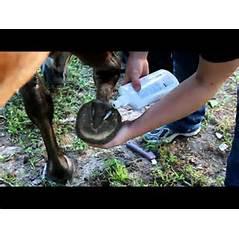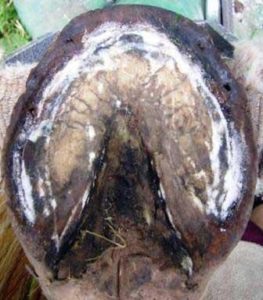
2016-04-15
Understanding & Treating Thrush in Horses
What is Thrush in Horses?
Thrush is a common anaerobic bacterial infection of the horse’s hoof tissue characterized by a black, necrotic (dead), foul-smelling material. Thrush typically affects the central frog or grooves adjacent to and in the middle the frog (collateral sulci). However, severe cases thrush can also invade the white line, sole, and sensitive layers of the foot.

In the normal foot, continuous movement prevents the accumulation of material in the bottom of the foot that can lead to thrush. When the horse bears weight on the limb, the third phalanx (coffin bone) descends, causing the sole to flatten. The coffin joint then descends as the navicular bone moves towards the ground. This movement pushes against the navicular bursa and the deep flexor tendon, resulting in the frog expanding as it approaches the ground surface.
Impairment of this hoof cleaning mechanism appears to be the outstanding cause of thrush, as thrush is seen in a large percentage of inactive horses that live in stalls.(2). When horses are confined to a stall or paddock, they are often not able to “self-clean” their hooves. A few causes that result in horses’ hooves becoming infected include:
- Abnormal hoof growth
- Inappropriate or lack of trimming or shoeing
- Lack of use/insufficient exercise
- Chronic lameness issues (resulting in decreased movement)
- Poor circulation to the frog
- Horses with deep sulci (clefts in the foot), such as draft breeds, or narrow or contracted heels also appear to be at increased risk for thrush.(1,3 )
Clinical Signs
Classic clinical signs of thrush include a thick, black, puttylike, malodorous degenerative material on and in the frog and the collateral and central sulci. Most horses with mild cases of thrush are not lame, but if the infection is severe and invades the sensitive layers of the foot, then cleaning and manipulating the frog can elicit a painful response. (3).
Diagnosis
Diagnosing thrush is usually straightforward, based on environmental conditions and clinical signs such as black debris/discharge, offensive odor, and frog loss. Culturing the foot to determine which disease-causing microorganism is specifically responsible for the infection is not typically rewarding, because the results are usually nonspecific. In addition, culture results will rarely (only in extreme cases) change the treatment.
Treatment
Successful treatment of thrush:
-
- Horse owners can photograph the offending hoof and email to azequine@aol.com and our veterinarians can help you!
- Identifying and correcting the underlying cause(s) of the infection. This will necessitate working with your veterinarian and farrier.
- The veterinarian or farrier should trim away the dead, infected tissue
- Identifying and correcting the underlying cause(s) of the infection. This will necessitate working with your veterinarian and farrier.
- Picking, cleaning, and medicating the affected foot/feet at least daily. Pick the foot and ensure it is as dry as possible before medicating. The foot can, on occasion, be scrubbed gently with water and a stiff brush
A variety of medicated thrush products are commercially available in several forms, including liquid and aerosol. Veterinarians recommend following the package instructions for application. Most cases of active thrush require daily use to resolve the infection. Systemic antibiotics can be utilized in severe cases. Depending on the patient’s hoof and heel conformation, corrective trimming and shoeing may be recommended.
Prevention
Thrush can occur in virtually any horse, regardless of the cleanliness of their stable situation. Picking, cleaning, and inspecting each foot every day is imperative to thrush prevention. Working with Arizona Equine veterinarians and your farrier will help ensure horse’s foot, including the frog, is healthy. Good daily management and regular turnout/exercise to promote natural hoof “cleaning” will help prevent most, if not all, cases of thrush.
References
1. Dabareiner, R.M.; Moyer, W.; Carter, G.K. “Trauma to the sole and the wall.” In: Ross, M.W., Dyson, S.J., eds. Diagnosis and Management of Lameness in the Horse. Philadelphia: Saunders; 2003:277.
2. Mendell, C. Thwarting Thrush. TheHorse.com/11097.
3. Loving, N.S. Thrush Diagnosis and Treatment. TheHorse.com/10253.

Sorry, the comment form is closed at this time.